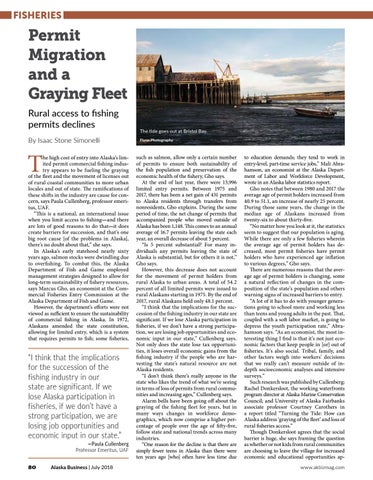FISHERIES
Permit Migration and a Graying Fleet Rural access to fishing permits declines By Isaac Stone Simonelli
T
he high cost of entry into Alaska’s limited permit commercial fishing industry appears to be fueling the graying of the fleet and the movement of licenses out of rural coastal communities to more urban locales and out of state. The ramifications of these shifts in the industry are cause for concern, says Paula Cullenberg, professor emeritus, UAF. “This is a national, an international issue when you limit access to fishing—and there are lots of good reasons to do that—it does create barriers for succession, and that’s one big root cause [of the problems in Alaska], there’s no doubt about that,” she says. In Alaska’s early statehood nearly sixty years ago, salmon stocks were dwindling due to overfishing. To combat this, the Alaska Department of Fish and Game employed management strategies designed to allow for long-term sustainability of fishery resources, says Marcus Gho, an economist at the Commercial Fisheries Entry Commission at the Alaska Department of Fish and Game. However, the department’s efforts were not viewed as sufficient to ensure the sustainability of commercial fishing in Alaska. In 1972, Alaskans amended the state constitution, allowing for limited entry, which is a system that requires permits to fish; some fisheries,
“I think that the implications for the succession of the fishing industry in our state are significant. If we lose Alaska participation in fisheries, if we don’t have a strong participation, we are losing job opportunities and economic input in our state.”
—Paula Cullenberg Professor Emeritus, UAF
80
The tide goes out at Bristol Bay. Flynn Photography
such as salmon, allow only a certain number of permits to ensure both sustainability of the fish population and preservation of the economic health of the fishery, Gho says. At the end of last year, there were 13,996 limited entry permits. Between 1975 and 2017, there has been a net gain of 431 permits to Alaska residents through transfers from nonresidents, Gho explains. During the same period of time, the net change of permits that accompanied people who moved outside of Alaska has been 1,148. This comes to an annual average of 16.7 permits leaving the state each year, an overall decrease of about 5 percent. “Is 5 percent substantial? For many individuals any permits leaving the state of Alaska is substantial, but for others it is not,” Gho says. However, this decrease does not account for the movement of permit holders from rural Alaska to urban areas. A total of 54.2 percent of all limited permits were issued to rural Alaskans starting in 1975. By the end of 2017, rural Alaskans held only 48.1 percent. “I think that the implications for the succession of the fishing industry in our state are significant. If we lose Alaska participation in fisheries, if we don’t have a strong participation, we are losing job opportunities and economic input in our state,” Cullenberg says. Not only does the state lose tax opportunities, it loses overall economic gains from the fishing industry if the people who are harvesting the state’s natural resource are not Alaska residents. “I don’t think there’s really anyone in the state who likes the trend of what we’re seeing in terms of loss of permits from rural communities and increasing ages,” Cullenberg says. Alarm bells have been going off about the graying of the fishing fleet for years, but in many ways changes in workforce demographics, which now comprise a higher percentage of people over the age of fifty-five, follow state and national trends across many industries. “One reason for the decline is that there are simply fewer teens in Alaska than there were ten years ago [who] often have less time due
to education demands; they tend to work in entry-level, part-time service jobs,” Mali Abrahamson, an economist at the Alaska Department of Labor and Workforce Development, wrote in an Alaska labor statistics report. Gho notes that between 1980 and 2017 the average age of permit holders increased from 40.9 to 51.1, an increase of nearly 25 percent. During those same years, the change in the median age of Alaskans increased from twenty-six to about thirty-five. “No matter how you look at it, the statistics seem to suggest that our population is aging. While there are only a few fisheries wherein the average age of permit holders has decreased, most permit fisheries have permit holders who have experienced age inflation to various degrees,” Gho says. There are numerous reasons that the average age of permit holders is changing, some a natural reflection of changes in the composition of the state’s population and others warning signs of increased barriers to entry. “A lot of it has to do with younger generations going to school more and working less than teens and young adults in the past. That, coupled with a soft labor market, is going to depress the youth participation rate,” Abrahamson says. “As an economist, the most interesting thing I find is that it’s not just economic factors that keep people in [or] out of fisheries. It’s also social. Tribal, family, and other factors weigh into workers’ decisions that we really can’t measure outside of indepth socioeconomic analyses and intensive surveys.” Such research was published by Cullenberg; Rachel Donkersloot, the working waterfronts program director at Alaska Marine Conservation Council; and University of Alaska Fairbanks associate professor Courtney Carothers in a report titled “Turning the Tide: How can Alaska address ‘graying of the fleet’ and loss of rural fisheries access.” Though Donkersloot agrees that the social barrier is huge, she says framing the question as whether or not kids from rural communities are choosing to leave the village for increased economic and educational opportunities ap-
Alaska Business | July 2018 www.akbizmag.com
